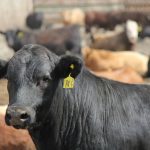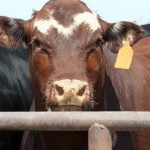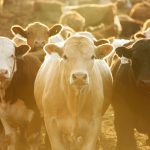Reading Time: < 1 minute Cattle futures on the Chicago Mercantile Exchange were down by their daily limits on Wednesday, with speculative long liquidation a feature. The December live cattle contract lost 7.250 cents per pound at 220.525 cents. Feeder cattle were down 9.250 cents in the January contract at 319.975 cents per pound. U.S. Agriculture Secretary Brooke Rollins met […] Read more

U.S. livestock: Cattle futures post limit-down losses

Klassen: Feeder market drops sharply
Reading Time: 2 minutes For the week ending November 1, Western Canadian feeder cattle markets traded $15-$30/cwt lower compared to seven days earlier. Cash feeder markets were off by $30-$40/cwt early in the week but then marginally recovered on Wednesday as the feeder cattle futures market stabilized. There were a few exceptions. Higher quality yearlings over 800 pounds coming […] Read more

Klassen: Feeder market softens on weaker demand
Reading Time: 2 minutes For the week ending October 25, Western Canadian yearling markets traded steady to $10/cwt below prices from the previous week. Calves in the range of 550 pounds to 850 pounds were down $8 to $12 on average while feeders under 550 pounds were relatively unchanged compared to seven days earlier. U.S. government comments regarding the […] Read more

U.S. livestock: Cattle futures plunge daily limits on beef price fears
Reading Time: < 1 minute Reuters — Most Chicago Mercantile Exchange live cattle and feeder cattle futures contracts fell their respective daily limits on Friday, as efforts by the U.S. to lower historically high beef prices appeared to spark a round of long liquidation by speculators, analysts said. CME benchmark December live cattle futures were down their daily maximum of […] Read more

U.S. livestock: Cattle futures mixed
Reading Time: < 1 minute Cattle futures on the Chicago Mercantile Exchange were mixed on Thursday, after dropping sharply the previous session. The December live cattle contract was up by 1.350 cents per pound at 241.175 cents. However, more deferred months were lower. Feeder cattle saw a continuation of Wednesday’s selloff, with the November contract down 2.775 cents at 361.450 […] Read more

New opportunities for Canadian goods in Mexico
Reading Time: 2 minutes Agriculture minister’s trip to Mexico sees promotion of Canadian goods like beef and canola, with potential for more partnerships in the future

Trump quadrupling Argentina beef tariff rate quota to 80,000 tonnes
Reading Time: 2 minutes U.S. President Donald Trump’s administration is quadrupling the tariff rate quota on Argentinian beef to 80,000 tonnes to reduce prices and protect American farmers, a White House official said on Thursday.

U.S. livestock: Cattle futures drop on Trump call for lower prices
Reading Time: < 1 minute Cattle futures on the Chicago Mercantile Exchange dropped sharply on Wednesday, reacting to comments from United States President Donald Trump calling on the cattle sector to lower prices. The December live cattle contract lost 5.600 cents per pound on Wednesday, at 239.825 cents. Feeder cattle were down their daily limit of 9.250 cents per pound […] Read more

Trump urges U.S. cattle ranchers to lower prices as he touts tariffs
Reading Time: 2 minutes U.S. President Donald Trump is calling on cattle ranchers to lower prices

Confusion cleared on Canadian calf import changes
Reading Time: 3 minutes A Canadian Food Inspection Agency (CFIA) announcement on import regulations for feeder calves caused some confusion on the administrative side of Canada’s cattle industry earlier this month


